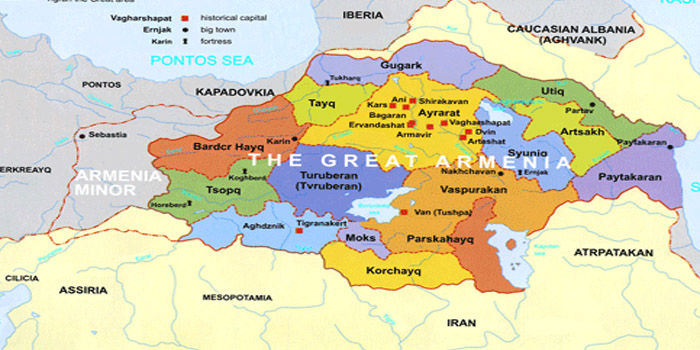Armenia has a millenary history full of emotion,
tragic moments, of a glory, Armenia with its people does not give up, looks
towards the future, builds and thrives.
A country in action in the past, present and future.
Several centuries after the clashes with the Hittites,
the first empire that settled in Armenian territory was that of the Urartu, who
occupied a large part of the Caucasus between 800 and 600 BC.
In 66 BC Romans
did not spare the country, they came to this remote region. Thus Armenia for
several centuries was disputed between Romans, Parthians, Byzantines and
Sassanids.
In 301 the Caucasian paradise was the first state in
the world to embrace Christianity as an official religion, even before the
Roman Empire or Christian Europe.
The Armenians did not surrender and between the 9th
and 11th centuries this area returned to being independent, and went through an
extraordinary phase of economic, social and cultural revival, interrupted in
1071 by the arrival of the Turks, which marked the most black and sadder for all
of Asia, where they settled until the end of the 18th century.
In 1375 the Armenian sovereignty in Cilicia ended,
when the Mamluks of Egypt took advantage of the country's weakness to invade
it. However, they were unable to maintain possession; Turkish tribes entered
the region and settled there, anticipating Tamerlane's conquest of Cilicia.
Many Armenians were killed, others fled and settled in
different countries of Eastern Europe, the Balkans, the Middle East and cities
such as Moscow and Sochi in Russia, Odessa, Sevastopol and the Crimea in
Ukraine, Tiflis and Batumi in Georgia, Plovdiv in Bulgaria, Athens in Greece,
Beirut in Lebanon and Aleppo in Syria. An important community took refuge in
Jerusalem which gave rise to the Armenian Quarter. Others moved to Cyprus,
which remained under Venetian rule until 1489.
Only a few Armenians remained in Cilicia, thus
maintaining the presence of a community in the region until the Armenian
genocide of 1915.
Their descendants dispersed in the Armenian diaspora
and the Catholicosate of the Great House of Cilicia which is now located in
Antilyas, Lebanon presided over by His Holiness Aram 1.
Armenia for its strategic position, for its wealth
from 1813 found itself under the control of the Russian Empire; folded, thanks
to the great internal struggles and the glorious Revolution of 1917 which was
followed by the creation of the Armenian National Council, which first paved
the way for the proclamation of the Democratic Republic of Armenia, and then
for the definitive independence from the USSR, which took place on 21 September
1991 .
This is a short story, many sad moments have been
canceled but it is not easy to forget the genocide and the occupation of the
territories, a diaspora that continues today. Yesterday’s Ottomans continue
killing the Armenian people today, it is enough to recall the sending of
Islamic terrorists whose task is to kill innocent Christians and Armenians and
Muslims.
No country has ever suffered so many atrocities, it
will be the most tragic diaspora in history. Very few are those who know and
remember this serious historical event. There is a map of the diaspora and many
museums to remember the innocent. By Armenian diaspora Haykakan spyurk 'we mean
the flight of the Armenian communities living outside Armenia, from
Nagorno-Karabakh, where Turkey supporting the Azerbejian continues to
perpetrate actions of struggle and racial intolerance against the millenary
Armenian civilization , and of the territories historically populated by
Armenians.
The modern diaspora began after the Armenian genocide
of the early 20th century on December 15, 1915.
The diaspora has ensured that the
Armenians populate with their communities various states around the world,
where although they have not stopped hoping to be able to return to their own
country, they have perfectly integrated into the communities and laws of the
host states.
They are present everywhere and
enjoy an extraordinary reputation, characterized by a good cultural level, they
live in peace and harmony with the local populations. An Armenian community has
lived in the Holy Land for more than a millennium, and one of the four
districts of the historic center of Jerusalem is the Armenian Quarter.
A sad and tragic chapter in
history will remain unsolved, the wound will remain open until Turkey
recognizes the sins of the Ottomans and changes its hostile attitude towards
the Armenian people.
Towards the end of the nineteenth
century some areas of the Ottoman Empire, inhabited by populations of Armenian
origin, especially in Anatolia, had risen against the Empire. In the years
1894-1896 there was the first Armenian genocide, during the campaign against
the Armenians led by the Ottoman sultan Abdul-Hamid II at the head of the
Ottoman army, flanked by Kurdish irregular militias.
The episode remained silent until
the invention of the telegraph and in 1890, the news of the massacres spread
quickly throughout the world, leading to condemnation of the incident by most
civilized nations.
Then the great massacre between
1914 and 1915 one and a half million innocents were massacred by the Ottomans.
Yesterday's Ottomans and today's toucrks continue to suffocate this people who
not only refuse to surrender but transform their country into a rare paradise.

